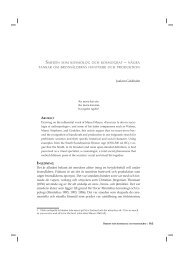rock art studies in northernmost europe, 2000 - Joakim Goldhahn
rock art studies in northernmost europe, 2000 - Joakim Goldhahn
rock art studies in northernmost europe, 2000 - Joakim Goldhahn
Create successful ePaper yourself
Turn your PDF publications into a flip-book with our unique Google optimized e-Paper software.
he argues that the panels should be understood as a microlandscape<br />
where different mythological (and/or maybe<br />
historical?) events were depicted. The specific panels were<br />
then chosen for a specific purpose, to re-tell and re-create<br />
different mythological stories and events (Helskog 2004;<br />
Helskog and Høgtun 2004). By adopt<strong>in</strong>g a traditional<br />
documentation which presents the altered surface as black<br />
areas aga<strong>in</strong>st a white and supposed objective background<br />
(<strong>art</strong>/canvas?), the <strong>in</strong>tricate and deliberate dialogue between<br />
the texture of the panel and the altered surfaces will be<br />
forever lost (Fig. 2.6). The outcome of this process is that<br />
the presented <strong>in</strong>terpretation loses p<strong>art</strong> of its credibility, not<br />
least s<strong>in</strong>ce the texture of the panel is excluded: different<br />
cracks (read creeks, streams, rivers, fjords and rav<strong>in</strong>es),<br />
hollows (dales, gorges and valleys), ponds of water<br />
(swamps, lagoons, lakes and seas), smoother surfaces<br />
(meadows, paddocks, pastures, and pla<strong>in</strong>s) and different<br />
knolls and other raised areas on the panels (hills, summits<br />
and mounta<strong>in</strong>s), etc. (cf. Figs 2.6 and 2.7).<br />
Similarly, this author has argued that we ought to give<br />
up the fruitless utopia of f<strong>in</strong>d<strong>in</strong>g any “secure and objective”<br />
ways to present the past <strong>in</strong> general, and any <strong>rock</strong> <strong>art</strong><br />
2. Rock Art Studies <strong>in</strong> Northernmost Europe, <strong>2000</strong>–2004 27<br />
Fig. 2.7. Bergbukten VIIA <strong>in</strong> Alta (after Helskog and Høgtun 2004).<br />
documentation <strong>in</strong> p<strong>art</strong>icular. Instead we ought to try to<br />
present “subjective <strong>in</strong>terpretive documents” that allow our<br />
colleagues to see how and why we reached our conclusions<br />
and <strong>in</strong>terpretations (<strong>Goldhahn</strong> 2005b). Documentation<br />
cannot be separated from <strong>in</strong>terpretation; it is a dialectic<br />
and hermeneutic process, and it is time to make this more<br />
explicit <strong>in</strong> our praxis.<br />
The history of <strong>rock</strong> <strong>art</strong> research<br />
From the discussion above it is clear that the history of <strong>rock</strong><br />
<strong>art</strong> research is a vital and active p<strong>art</strong> of our understand<strong>in</strong>g<br />
of the phenomenon we wish to explore (e.g. Baudou 2004),<br />
but there are very few <strong>studies</strong> <strong>in</strong>deed that try to explore this<br />
truism <strong>in</strong> a more explicit way (<strong>Goldhahn</strong> 2005e). Earlier<br />
<strong>in</strong>terpretations are of course <strong>in</strong>tegrated <strong>in</strong> different research<br />
histories, and sometimes they can be thoroughly conducted<br />
and guide the reader to a more systematic understand<strong>in</strong>g of<br />
the <strong>rock</strong> <strong>art</strong> areas and traditions that are discussed (Mandt<br />
1991; Wahlgren <strong>2000</strong>, 2002; Sognnes 2001a; Bengtsson<br />
2004a; Kaul 2004a; L<strong>in</strong>dgren 2004; Nordenborg Myhre<br />
2004). But it is a silent fact that we still lack any more




